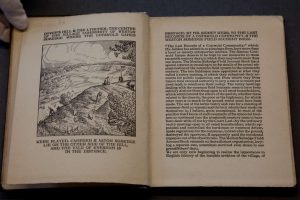Case four: The Essex House Press continued
Influenced by the work of Ruskin, Ashbee believed that a healthy work environment was necessary for good craftsmanship, and the Guild of Handicraft’s location in smoky industrial Whitechapel was certainly not such a place. In 1901 he set his eye on Chipping Campden, a medieval wool town that had fallen on hard times. Many of the houses were empty, and Ashbee envisioned the town filled with new life and the sound of goldsmith’s hammers, carpenter’s saws and click-clacking looms. The Guild took a vote, and with a clear majority in favour they made the move in 1902. In their new home they set up workshops, cultivated extensive gardens and even assembled a library. The countryside was perhaps too idyllic for some members of the community, however, who grew restless in the slow, quiet atmosphere. The Guild also struggled to find a balance between art, intellectual activity and labour. It soon became apparent that no matter how worthwhile it was to have long afternoon sketching classes, someone had to weed the gardens.
This account of the Cotswold Games, a sporting event begun in the 17th century and held near Chipping Campden, is an example of Ashbee and the Guild of Handicraft’s fascination with what they considered to be a primitive rural life, free from the restraints and distractions of the city.

![C.R. (Charles Robert) Ashbee, 1863-1942. The last records of a Cotswold community : being the Weston Subedge field account book for the final twenty-six years of the famous Cotswold games, hitherto unpublished and edited with a study on the old time sports of Campden and the village community of Weston. [Chipping Camden, Essex House Press], [1904].](../wp-content/uploads/sites/19/2014/02/4_1_Ashbee_Cotswolds-web-300x200.jpg)
